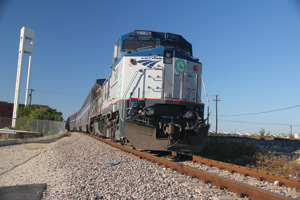Biodiesel Gets On Track

December 20, 2010
BY Bryan Sims
What do Apple's iPad, improved 3-D glasses and Amtrak's Heartland Flyer locomotive have in common? They all made Time magazine's list of "The 50 Best Inventions of 2010." The Heartland Flyer, which makes daily runs between Oklahoma City and Fort Worth, Texas, was the only one of Time's 10 transportation innovations available to the public on the "50 Best" list.
Amtrak received a $274,000 grant from the Federal Railroad Administration to study the feasibility and effectiveness of using B20 in its Heartland Flyer locomotive. Amtrak conducted the 12-month long trial experiment in partnership with the Oklahoma and Texas Departments of Transportation.
"Amtrak travel is already more energy efficient than most other forms of inter-city transportation," says Roy Deitchman, vice president of environmental health and safety for Amtrak. "If the test shows this use of a renewable fuel in our locomotive is successful, it's a home run for our passengers, for our partners and for the planet."
Powered by a 3,200-horsepower General Electric P32-8 locomotive with a 12-cylinder diesel engine, Amtrak announced that the Heartland Flyer would be running on B20 on Earth Day in February 2010. The locomotive subsequently received a decal in April indicating that it used nothing but B20 on its regular stops through Norman, Okla., Purcell, Okla., Pauls Valley, Okla., Ardmore, Okla., and Gainesville, Texas. The Heartland Flyer is fueled in Fort Worth by Amtrak's existing fuel vender, Euless, Texas-based Direct Fuels, which provides beef tallow-derived biodiesel.
"The cost difference between a biodiesel blend and straight ultra-low sulfur diesel is about a nickel per gallon to what it was a few years ago," says Amtrak spokesman Marc Magliari, adding that the train does a daily 400-mile round trip between Fort Worth and Oklahoma City, burning about 100,000 gallons of fuel a year in the process.
As part of maintenance and inspections during the trial run test, according to Magliari, Amtrak will perform analysis of the engine oil every 10 days for degradation and/or dilution, including wear and tear on gaskets and valves. At the end of the trial test in April 2011, Amtrak will collect locomotive exhaust emissions data in accordance with U.S. EPA locomotive exhaust emissions federal test protocol in the final report. The trial has received support on fuel and engine component evaluation from Chevron Oronite.
Previously conducted stationary locomotive engine testing of B20 has shown to reduce hydrocarbon and carbon monoxide each by 10 percent, particulates by 15 percent and sulfates by 20 percent, according to Amtrak.
In an effort to control quality, all the batches of biodiesel are tested in conforming to parameters set by the BQ-9000 program. "We also test for water content, viscosity and carbon residue on every batch," Magliari says. Additionally, at least one batch is tested for metals content and sulfated ash on a monthly basis, along with semiannual testing of cetane and distillation parameters.
According to Amtrak, ridership in the 12 months ending Sept. 30 stood at 81,749, up 11 percent from the previous year, while ridership in October increased by more than 17 percent compared to the same period in 2009.
Amtrak received a $274,000 grant from the Federal Railroad Administration to study the feasibility and effectiveness of using B20 in its Heartland Flyer locomotive. Amtrak conducted the 12-month long trial experiment in partnership with the Oklahoma and Texas Departments of Transportation.
"Amtrak travel is already more energy efficient than most other forms of inter-city transportation," says Roy Deitchman, vice president of environmental health and safety for Amtrak. "If the test shows this use of a renewable fuel in our locomotive is successful, it's a home run for our passengers, for our partners and for the planet."
Powered by a 3,200-horsepower General Electric P32-8 locomotive with a 12-cylinder diesel engine, Amtrak announced that the Heartland Flyer would be running on B20 on Earth Day in February 2010. The locomotive subsequently received a decal in April indicating that it used nothing but B20 on its regular stops through Norman, Okla., Purcell, Okla., Pauls Valley, Okla., Ardmore, Okla., and Gainesville, Texas. The Heartland Flyer is fueled in Fort Worth by Amtrak's existing fuel vender, Euless, Texas-based Direct Fuels, which provides beef tallow-derived biodiesel.
"The cost difference between a biodiesel blend and straight ultra-low sulfur diesel is about a nickel per gallon to what it was a few years ago," says Amtrak spokesman Marc Magliari, adding that the train does a daily 400-mile round trip between Fort Worth and Oklahoma City, burning about 100,000 gallons of fuel a year in the process.
As part of maintenance and inspections during the trial run test, according to Magliari, Amtrak will perform analysis of the engine oil every 10 days for degradation and/or dilution, including wear and tear on gaskets and valves. At the end of the trial test in April 2011, Amtrak will collect locomotive exhaust emissions data in accordance with U.S. EPA locomotive exhaust emissions federal test protocol in the final report. The trial has received support on fuel and engine component evaluation from Chevron Oronite.
Previously conducted stationary locomotive engine testing of B20 has shown to reduce hydrocarbon and carbon monoxide each by 10 percent, particulates by 15 percent and sulfates by 20 percent, according to Amtrak.
In an effort to control quality, all the batches of biodiesel are tested in conforming to parameters set by the BQ-9000 program. "We also test for water content, viscosity and carbon residue on every batch," Magliari says. Additionally, at least one batch is tested for metals content and sulfated ash on a monthly basis, along with semiannual testing of cetane and distillation parameters.
According to Amtrak, ridership in the 12 months ending Sept. 30 stood at 81,749, up 11 percent from the previous year, while ridership in October increased by more than 17 percent compared to the same period in 2009.
Advertisement
Advertisement
Upcoming Events





